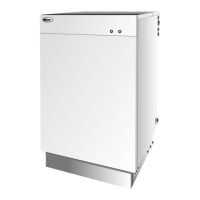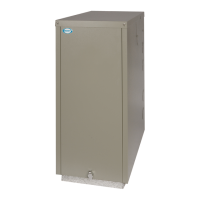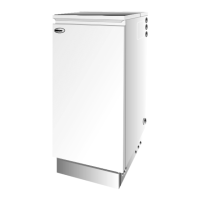43
Combi 70 & Combi 90 Oil Boilers
5 Reconnect the flexible hose, ensuring that the
sealing washer is correctly fitted in the union
before tightening.
6 Before filling and re-pressurising the heating system
- Check the charge pressure in the expansion vessel
using a suitable pressure gauge. See section 5.1.
7 Refill the central heating system as described in
section 5.2.
1 The check valve is located in the 22 mm heating
flow pipe behind the circulating pump.
2 Drain the central heating system and boiler using
the drain cock on the boiler.
3 Unscrew and disconnect pipe union 3 from the rear
of the diverter valve. See Fig. 38.
4 Close the pump isolating valve, undo both pump
unions, remove the pump and lay it to one side on
top of the burner. Take care not to strain the
electrical cable to the pump.
5 Unscrew and disconnect the top compression
connection on the check valve and withdraw the
pipe and valve from the boiler.
6 Unscrew the lower compression connection to
disconnect the valve from the pipe. Fit a
replacement check valve using the reverse of the
above procedure.
Important: Ensure that the check valve is fitted
the correct way round, i.e. with the arrow
indicating direction of flow pointing UPWARDS.
7 Refit the pump using the reverse of the above
procedure, ensuring that the sealing washers are
correctly fitted in the pump unions, and that the
pump flow direction (pointing downwards) is
correct.
8 Refill the central heating system as described in
section 5.2, checking for leaks.
1 Shut off the cold water supply to the boiler at the
mains stopcock.
2 Drain the central heating system and boiler using
the drain cock on the boiler.
3 Slacken the four control panel fixing screws,
carefully disengage the control panel from both
casing side panels and the front top panel and
allow it to rest at an angle on its right hand end.
4 Working from the front of the boiler, if it is not
possible to remove the front top casing panel (e.g.
if the boiler is situated under a fixed worktop),
disconnect the cold water inlet pipe at both the
elbow connector in the top of the boiler, and at
connection 5 on the cold inlet isolating valve (A),
see Fig. 39.
5 Carefully manoeuvre the pipe forwards and then
down by about 100 mm to leave access to the two
compression connections on the check valve.
6 Unscrew both compression nuts on the check valve
and remove it from the boiler.
7 Fit a replacement check valve using the reverse of
the above procedure.
Important: Ensure that the check valve is fitted
the correct way round, i.e. with the arrow
indicating direction of flow pointing TO THE
LEFT.
8 Open the cold water supply to boiler at the mains
stopcock. Refill the central heating system as
described in section 5.2, checking for leaks.
1 From above the boiler, remove the front top casing
panel by pulling it up on one side to disengage the
four push-in fasteners.
2 If a conventional flue is fitted to the boiler, unhook
the flexible air tube from the hook bracket on the
cross member. Unscrew and remove the nut and
bolt fixing fastening from the centre of the
crossmember. Unscrew the four fixing screws and
remove the crossmember from the boiler.
3 Drain the central heating system and boiler using
the drain cock on the boiler.
4 Unscrew the capillary tube nut and disconnect it
from the valve.
5 Unscrew the discharge pipe compression nut and
disconnect it from the valve.
6 Unscrew the valve union and remove the valve
from the boiler.
7 Fit a replacement valve using the reverse of the
above procedure, ensuring that the sealing washer
provided is correctly fitted in the valve union
before tightening.
8 Refill the central heating system as described in
section 5.2, checking for leaks.
9 Manually operate the relief valve to check it’s
operation, then refill as above.
9 - REPLACEMENT OF BOILER COMPONENTS
Check valve - Combi 70
9.6
Check valve - Combi 90
9.6a
Pressure relief (safety) valve - Combi 70
9.7

